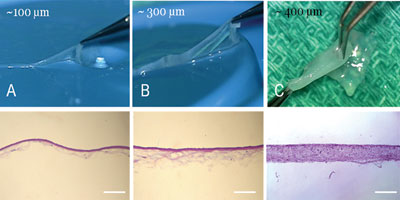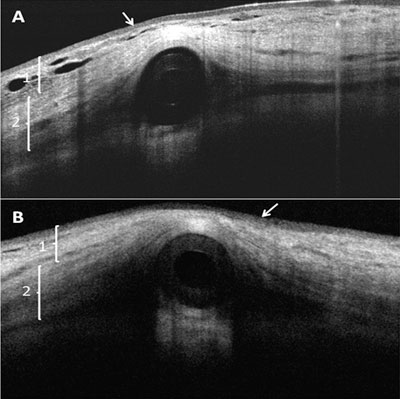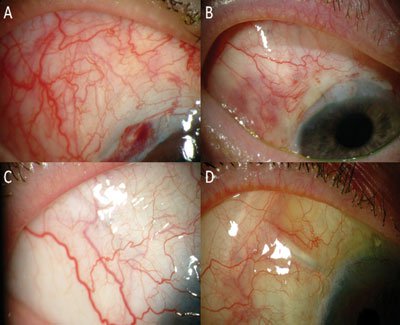Amniotic membrane graft may reduce glaucoma drainage device exposure
There was no thinning or melting of the membrane during follow-up, and the membrane appeared to show an increased cell density over time.
 Thomas John |
Biologically separate entities, amnion and chorion, comprise the fetal membranes. In the early 1900s, fetal membranes were used in skin transplantation to treat burned and ulcerated skin surfaces. However, it was not until 1940 when De Röth used fetal membranes on the ocular surface to treat symblepharon caused by chemical injury. It took another half a century before the potential uses of amniotic membrane were recognized for various ocular surface-related diseases, including pterygium surgery, persistent epithelial defects, bullous keratopathy, chemical injury, thermal burns, neurotrophic corneal ulcer, leaking filtering blebs, Stevens-Johnson syndrome, toxic epidermal necrolysis, ocular surface and fornix reconstruction.
Amniotic membrane (AM) provides tissue replacement when host conjunctival tissue is unavailable or restricted due to various disease states; in addition, it is used for its biological properties, including anti-inflammatory, antifibrotic, antiangiogenic and antimicrobial properties. Commercially available AMs in the U.S. include both cryopreserved and freeze-dried preparations.
In glaucoma drainage device surgery, ophthalmic surgeons need to manage delayed postoperative complications, such as tubal exposure on the ocular surface, as this can potentially result in vision-threatening ocular infection. In an attempt to prevent tubal exposure, donor materials such as pericardium and sclera have been routinely utilized during glaucoma drainage device surgery. In this column, Dr. Sheha describes the use of a newly developed AM for glaucoma drainage device surgery. Further studies with long-term follow-up will provide data on the effectiveness of such procedures.
Thomas John, MD
OSN Surgical Maneuvers Editor
While the tough, semi-transparent nature of AM is valuable as a graft for ocular surface reconstruction, it is the low immunogenicity, anti-inflammatory, antimicrobial and antifibrotic properties of AM during embryogenesis that have spawned increasing interest over the past decade.
Several case reports have demonstrated success with cryopreserved AmnioGraft (BioTissue) (Figure 1a) as a conjunctival substitute in cases with tube erosion. AmnioGuard (BioTissue) (Figures 1b and 1c), a translucent and high-tensile strength tissue product obtained from a thicker section of the AM, is cryopreserved and processed via a proprietary method. It is tailored for use as an alternative graft to cover glaucoma drainage devices and prevent tube erosion (Figure 1c). I have evaluated an early version of AmnioGuard called AmnioGraft-G (Figure 1b) through grant support from the National Institutes of Health and successfully demonstrated its short-term safety and efficacy in preventing tube exposure during the primary implantation in a phase 1 study.
Forty-four patients underwent Baerveldt or Ahmed valve implantation performed by a single surgeon, Celso Tello, MD, of New York Eye and Ear Infirmary. The 2.3% incidence of tube exposure in this study with a mean 14 months of follow-up is comparable to the literature on current materials being used for tube coverage. Furthermore, sequential anterior segment optical coherence tomography images showed no thinning or melting of the AM during the follow-up period. The conjunctiva and AM bilayer covering the tube maintained its thickness, with a change from low to high reflectivity (Figure 2). These findings suggest that the biologically active AM may work differently from other materials such as pericardium, sclera or cornea. AM appears to show an increased cell density over time without loss of the conjunctiva-AM bilayer thickness, suggesting gradual integration with the host tissue.
 Figure 1. Comparison between the regular-thickness AmnioGraft (a), thicker AmnioGraft-G (b) and AmnioGuard (c). Histology shows that all have the same thickness of the epithelium and basement membrane, while the spongy stroma is thicker in AmnioGraft-G and the compact stroma is thickest in AmnioGuard. Images: Sheha H |
 Figure 2. Anterior segment OCT images at 3 months (a) and 12 months (b) postoperatively. The conjunctiva (arrow) remained intact. The thickness of the subconjunctival tissue (1) and AM graft (2) remained constant with a change in reflectivity, suggesting increased cell density over time. |
 Figure 3. Postoperative photographs showing the superior temporal quadrant of the conjunctiva over the AM graft and tube shunt at 1 week (a), 1 month (b), 6 months (c) and 12 months (d). |
Tube migration, retraction, kinking and twisting are known complications of glaucoma drainage devices and need immediate attention. While these may be difficult to diagnose under opaque pericardial or scleral patch grafts, the translucency of AM permitted direct visualization of the course of the tube from the plate to the point of scleral entry (Figure 3) and allowed easy laser suture lysis of the occluding suture in eyes with Baerveldt implants.
A continuous low-grade mechanical trauma, in cases in which the tube does not rest totally flush to the sclera, has been described as one of the causes of delayed tube erosion. Our postoperative anterior segment OCT images suggest that the pliable AM molds well around the tube (Figure 2). This may help not only in keeping the tube flush to the sclera but may also eliminate the potential dead space between the tube and the graft, thus preventing a possible nidus for low-grade infection. We speculate that the low profile of AM may also reduce the postoperative risk of dellen formation. A good covering of conjunctival tissue appears imperative both as a scaffold and as a source of cells for an AM to achieve its full tensile strength. The single incidence of tube exposure in our study occurred 5 weeks after surgery following conjunctival retraction. This suggests that the single-layer AM may not integrate with the host tissue and achieve full tectonic strength in eyes with conjunctival shortening from multiple previous surgeries or moderate-severe ocular surface disorder.
We are conducting a comparative, multicenter study to assess the long-term safety and efficacy of using AmnioGuard to secure the glaucoma drainage device tube and to confirm its overall superiority over pericardium in reducing conjunctival erosion and tube exposure in patients with high-risk glaucoma. Furthermore, we will deploy anterior segment OCT imaging to better understand the fate of the AM in the subconjunctival space. This study may position AmnioGuard as a better alternative to the existing patch grafts to reduce tube exposure and enhance the success of glaucoma drainage device implantation. If AmnioGuard proves its efficacy in the subconjunctival space for the use of covering glaucoma drainage devices, we anticipate that it may also contribute to the treatment of other ocular diseases in which a stronger and thicker surgical graft is required.
References:
- John T. Human amniotic membrane transplantation: past, present, and future. Ophthalmol Clin North Am. 2003;16(1):43-65.
- John T, Foulks GN, John ME, Cheng K, Hu D. Amniotic membrane in the surgical management of acute toxic epidermal necrolysis. Ophthalmology. 2002;109(2):351-360.
- Rai P, Lauande-Pimentel R, Barton K. Amniotic membrane as an adjunct to donor sclera in the repair of exposed glaucoma drainage devices. Am J Ophthalmol. 2005;140(6):1148-1152.
- Sheha H, Liang L, Tseng SC. Amniotic membrane grafts for glaucoma surgery. In: Schacknow PN, Samples JR, eds. The Glaucoma Book. New York: Springer; 2010:861-866.
- Smith MF, Doyle JW, Ticrney JW Jr. A comparison of glaucoma drainage implant tube coverage. J Glaucoma. 2002;11(2):143-147.
- Thomas John, MD, is a clinical associate professor at Loyola University at Chicago and is in private practice in Oak Brook, Tinley Park and Oak Lawn, Ill. He can be reached at 708-429-2223; fax: 708-429-2226; email: tjcornea@gmail.com.
- Hosam Sheha, MD, PhD, is an ophthalmology consultant at the Ocular Surface Center, Miami. He can be reached at 305-710-4709; email: hoss88@gmail.com.
- Disclosures: Dr. John has no relevant financial disclosures. Dr. Sheha is the director of clinical research at TissueTech, which owns U.S. patents 6,152,142 and 6,326,019 on the method of preparation and clinical uses of human amniotic membrane. The study mentioned in this article was supported in part by grant EY019785 from the National Eye Institute. The content is solely the responsibility of Dr. Sheha and does not necessarily represent the official views of the National Eye Institute or the National Institutes of Health.

